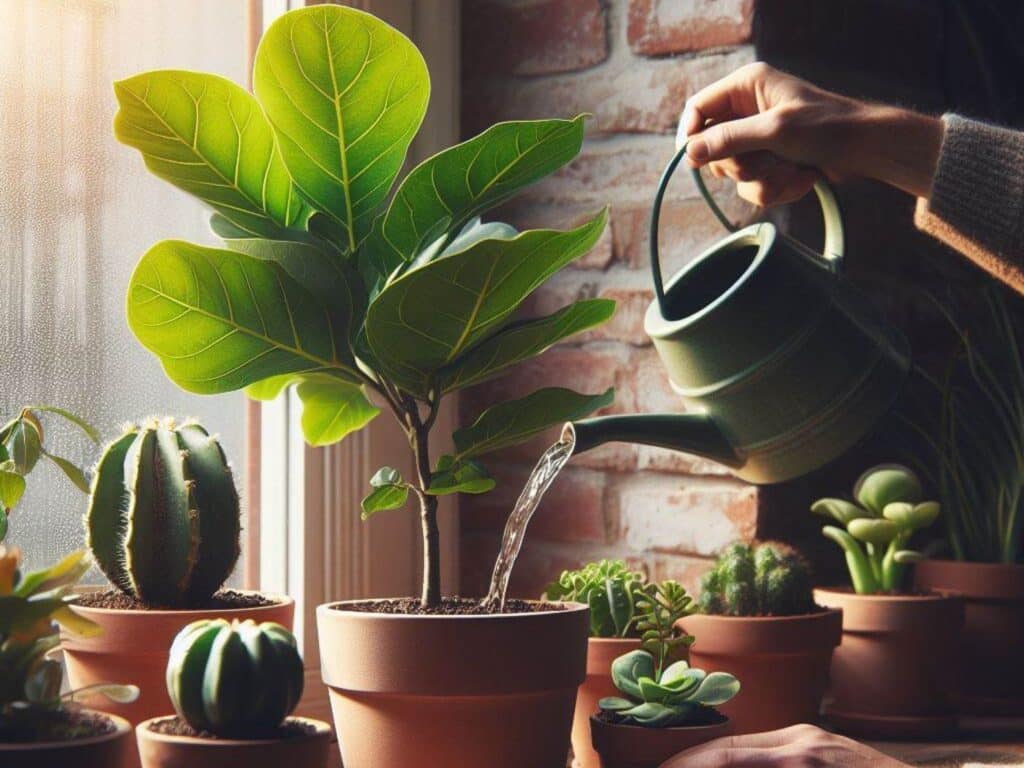Discovering your fiddle leaf fig’s leaves drooping and turning yellow can be disheartening, especially when you’ve been attentively watering it, thinking you’re providing the care it needs.
Overwatering is a common pitfall for fiddle leaf fig owners, often stemming from a desire to give their plant the best possible care. This well-intentioned mistake, however, can lead to a host of problems that compromise the health and beauty of your beloved plant.
Understanding the signs of overwatering, the reasons behind it, and how to address it is crucial for reviving your fiddle leaf fig. This article is designed to guide you through identifying the symptoms of overwatering, explaining why it’s harmful to your plant, and offering effective solutions to help your fiddle leaf fig thrive once again.
Let’s embark on a journey to restore the vitality of your overwatered fiddle leaf fig, turning a common mistake into a valuable learning experience.
Signs of an Overwatered Fiddle Leaf Fig
Recognizing the signs of an overwatered fiddle leaf fig is crucial for its revival. Missteps in watering can lead to a range of health issues for your plant. Let’s dive into the symptoms that shout “Too much water!”
Yellowing Leaves
Yellow leaves aren’t making your fiddle leaf fig any more fashionable. Instead, they signal distress. Overwatering prevents roots from absorbing oxygen properly, leading to yellowing. If your plant’s leaves start looking like they’ve lost their vibrant green, it’s time to reconsider your watering routine.
Root Rot and Mushy Stem Base
A mushy stem base feels as unpleasant as it sounds and is a direct cry for help from your plant. When too much water lurks at the base, it creates a prime environment for root rot, which can quickly escalate into a life-threatening situation for your fiddle leaf fig. If the base feels soggy or you spot blackened roots, prompt action is needed.
Dropping Leaves
Leaves dropping faster than hot potatoes is a clear sign your fiddle leaf fig is in distress. While it’s normal for plants to shed older leaves, a rapid loss indicates overwatering issues. If it’s dropping leaves as if trying to mimic fall inside your home, it’s time to evaluate your watering schedule.
Mold or Odor in the Soil
Sniffed something funky near your plant lately? A musty odor or visible mold growth atop the soil indicates excess moisture.
This not only affects the plant’s health but can also turn your indoor garden into a less pleasant experience. If the soil smells more like a damp basement and less like fresh earth, it’s a sign to let the soil dry out more between waterings.
Addressing these signs early can help prevent further damage to your fiddle leaf fig. By adjusting your care routine, you give your plant a fighting chance to return to its lush, green glory.
Causes of Overwatering in Fiddle Leaf Figs

Overwatering happens to be a common misstep with fiddle leaf figs, leading to several health issues for these trendy plants. Let’s dive into why your fiddle leaf fig may well be getting too much water, despite your best intentions.
Incorrect Watering Schedule
You may well have set a watering schedule that doesn’t match your plant’s needs. Fiddle leaf figs require less water than you’d think. If you’re watering them on a fixed schedule regardless of the soil’s moisture level, you’re likely overdoing it.
Adjust your watering routine based on the soil’s dryness. Stick your finger into the soil; if it’s still moist an inch below the surface, your plant doesn’t need water just yet.
Poor Drainage System
A subpar drainage system turns a pot into a swamp, and no fiddle leaf fig wants to live in a swamp. Ensure your plant’s pot has enough holes at the bottom to allow excess water to escape.
If it doesn’t, consider repotting the plant or adding more drainage holes to its current pot. Also, a tray under your pot may well seem like a neat solution to avoid spills, but empty it regularly to prevent water from being reabsorbed.
Environmental Factors
Lastly, don’t overlook the impact of your home’s environment. High humidity and low light conditions slow the evaporation of soil moisture. If your fiddle leaf fig is in a dimly lit corner or a humid room, it won’t need water as frequently.
Also, during the cooler months, your plant’s water needs decrease. Pay attention to these environmental cues and adjust your watering accordingly to keep your fiddle leaf fig in top shape.
Preventing Overwatering in Fiddle Leaf Figs
Assessing Soil Moisture Before Watering
Checking the soil’s moisture levels before watering your fiddle leaf fig is like a secret handshake between you and your plant. Stick your finger about an inch into the soil; if it feels damp, your green buddy isn’t thirsty yet.
Waiting until the top inch of soil dries out tells you it’s time for a drink. This simple step dodges overwatering, keeping those fiddle leaf fig leaves perky and happy.
Choosing the Right Pot and Soil Type
When it comes to pots, think of your fiddle leaf fig as a celebrity demanding the best suite in the hotel. A pot with adequate drainage holes steals the show here, preventing water from throwing a pool party at the root’s expense.
Choosing the right soil type is equally crucial. Pair this with a well-draining soil mix designed for indoor plants, and you’ve set the stage for a thriving fiddle leaf fig, free from the drama of overwatering.
Understanding the Water Needs of Your Plant
Fiddle leaf figs aren’t one-size-fits-all when it comes to their hydration needs. Like people, each plant’s thirst varies based on its environment. Bright light and higher temperatures mean more frequent waterings, while cooler, less sunny spots slow down the drinking schedule.
Paying attention to your plant’s specific needs, rather than sticking to a rigid watering calendar, guards against overhydration mishaps, keeping your leafy friend thriving.
Treatment for an Overwatered Fiddle Leaf Fig
Reviving an overwatered fiddle leaf fig involves a few key steps that target the root of the issue – quite literally! Let’s dive into the solutions.
How to Dry Out the Soil
The first task at hand is drying out the soggy situation your plant finds itself in. Begin by halting all watering activities immediately. Yes, put that watering can away! Next, move your plant to a well-lit area but steer clear of direct sunlight, as this could stress the plant further.
You may well think, “Should I just let it be?” Well, in some cases, pulling the plant out of its pot to let the roots and soil air out more effectively can work wonders. This method allows excess moisture to evaporate faster than it would if the plant were left in the pot.
Addressing Root Rot
Root rot is a tricky adversary and requires action fast. If you detect any mushy or black roots, it’s time for surgery. With clean, sharp scissors, cut away the damaged roots carefully. Remember, it’s like giving your plant a haircut, you’re removing the bad parts to let the good grow.
After trimming, treat the healthy roots with a fungicide to protect against further fungal attacks. Then, repot the plant into fresh, well-draining soil, ensuring you’re placing it in a pot with drainage holes to prevent future waterlogging.
When and How to Repot
Repotting comes next if your fiddle leaf fig has outgrown its current home or if the soil and pot need refreshing to enhance drainage. Choose a pot that’s just one to two inches larger in diameter than the current one.
You’re not moving your plant to a mansion, just giving it a bit more room to grow. Use a well-draining soil mix specifically designed for fiddle leaf figs, as this will help keep water levels optimal.
Gently transfer your plant, tease out the roots slightly to encourage them to spread out, and place it in its new pot. Compact the soil lightly around the roots and water sparingly to settle it in. Remember, after such a dramatic experience, your fiddle leaf fig will appreciate a period of stability to recover fully.
By following these steps, you actively combat the effects of overwatering, ensuring your fiddle leaf fig has the best chance of bouncing back. Don’t forget, patience is key; give your plant some time to show signs of recovery.
Long-Term Care for a Fiddle Leaf Fig
After overcoming the hurdle of overwatering your fiddle leaf fig, establishing a routine for its ongoing care is crucial. By focusing on watering practices, lighting, temperature conditions, and regular maintenance, you’ll set the stage for a thriving plant.
Monitoring Watering Practices
Guesswork won’t do; your fiddle leaf fig’s watering needs depend on several factors, including pot size, soil type, and environmental conditions. Use the finger test—dip your finger about 2 inches into the soil; water if it feels dry, skip if it feels moist.
This simple test surpasses any fixed watering schedule, adapting to your plant’s needs and avoiding future overwatering drama.
Optimal Lighting and Temperature Conditions
Fiddle leaf figs love light—bright, indirect light to be precise. Place your plant near a window that bathes it in soft sunlight, but don’t let it sunbathe for too long, or you’ll have a sunburnt situation on your hands.
Temperature-wise, these plants prefer a warm and stable environment; think temperatures between 60-75°F (15-24°C). Drafty windows or doors? Not their cup of tea. Keep them away from sudden temperature changes to avoid stress.
Regular Maintenance Tips
Let’s talk dust—not the most thrilling topic, but your fiddle leaf fig despises dust as much as you do. Regularly dusting the leaves not only keeps the plant looking fresh but also supports healthy photosynthesis.
Every few months, consider giving your plant a gentle shower to wash off any accumulated dust. Yes, a shower. Just ensure the soil doesn’t turn into a mud bath in the process. Also, be on the lookout for brown spots or leaf drop, which could indicate issues beyond overwatering, requiring a quick adjustment in care.
By adhering to these guidelines, you’re not only recovering an overwatered fiddle leaf fig but also championing its long-term health and growth. Remember, a happy fiddle leaf fig is a stunning addition to any space, offering that pop of green elegance we all crave.







